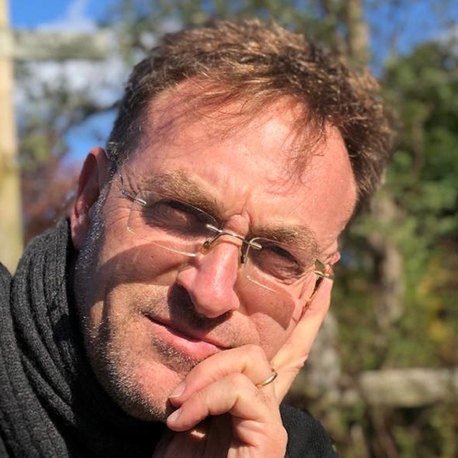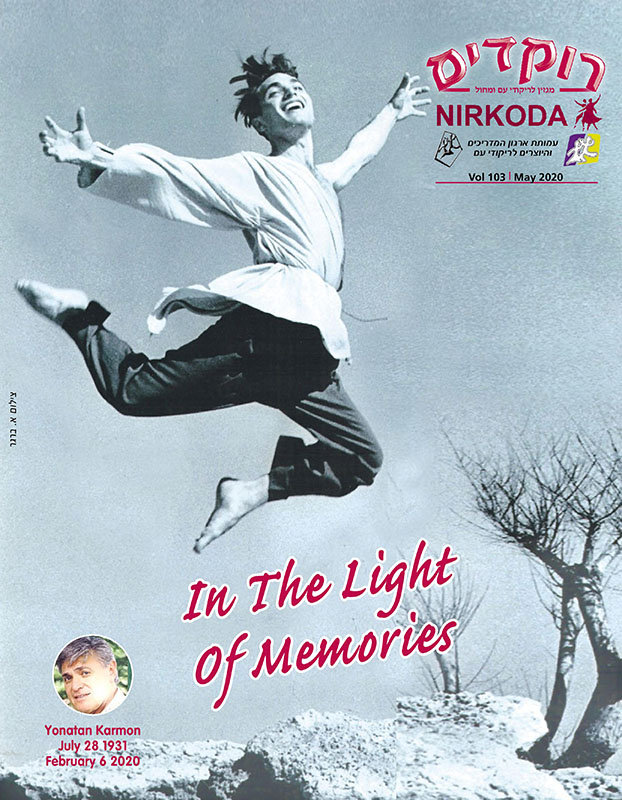- Home
- Rokdim Nirkoda 103
- Yonatan Karmon – The Man and The Creation
Yonatan Karmon – The Man and The Creation
From The Recommendation For The Israel Prize
- Translation: Ruth Goodman
- Translation: Tzipi Shragai
Yonatan Karmon was born in Bucharest, Romania in 1931 with the name Yonel Kalman, to his parents, Marcello and Silvia Kalman. When he was 13, his parents were taken to the labor camps and he managed to escape from the claws of the Nazis on the Kastner rescue train.
In 1944, he immigrated to Israel with “Aliyat Hanoar” – the Youth Aliyah and moved to “Meshek HaPoalot” in Tel Aviv to study agriculture and then to “Ayanot”, where he specialized in dairy farming.
His life was intertwined with the history of the Land of Israel: the working settlement, the Palmach, the “Dalia” Festival, the establishment of Israeli folk dance troupes, representation throughout the world, producing historic events over the years from 1944 and performing in them.
Yonatan was invited to artistically conduct and direct nature festivals and other holiday celebrations in the working settlements: at Sha’ar HaNegev, Tzor’a, Shoval, Nir Banim, Ramat HaShofet, Palmachim. These performances were examples and masterpieces, as they expressed the pioneering spirit, which was so characteristic of the early settlement of the country and has been a source of emulation for many years. The holidays in Israel have been glorified in the folk dance as a source of authentic Israeli expression.
Yonatan Karmon’s activities in the 1950s:
He created a choreography for the show to inaugurate the instillation of the national pipeline in Rosh Ha’Ayin directed by Peter Frey.
He performed as a soloist in HaPortzim Battalion and choreographed for Lehakat “Harel” of the Palmach directed by Rivka Shturman.
In the IDF he served in the Artillery Battalion but continued to dance and perform with Lehakat “Harel” of the Palmach, which was a folk dance troupe. Yonatan did not give up on developing his professional side; he trained and was part of the Israeli ballet troupe of Gertrude Kraus, participated in performances by the Israeli Opera and Naomi Aleskovsky’s Chamber Quartet.
From the mid-1950s, Yonatan established dance troupes around the country for which he directed and composed choreographies, all in the spirit of time and place. His work is unique and special with a folkloric direction from which he built artistic lines, intelligently, with talent, imagination and creativity, combining a story that is illustrated with every step and movement. His dances are filled with sweeping, bursting energy that uses space, captivates and excites the dancers and spectators alike.
Karmon ‘s troupes were numerous and exquisite: Lehakat “Alumim” of the Gadna in Petach Tikva, Lehakat “HaPoel Tel Aviv” Lehakat “HaStudentim Shel Yerushalaym” and “HaLehaka HaMerkazit Shel HaHistadrut” (which became “Lehakat Karmon”).
At the fourth “Dalia Festival” in 1958, the Histadrut’s main troupe appeared in the choreography of Yonatan Karmon and was the crowning highlight of the festival. It was already possible to discern the distinctive talent of Karmon as a unique creator who combines art, professionalism, theatrical and folk, and embedded in all that is the essence of the Israeli dance of yore, which is still so relevant and exciting even today.
The Lehaka was considered Israel’s best cultural ambassador in those days:
1958 – In nationwide auditions (see Itamar Zukerman‘s article in this issue) Ed Sullivan chose the renowned Lehakat Karmon to appear on his prestigious television show. Thus, the troupe embarks on a long and comprehensive tour on behalf of the Zionist Congress.
These shows in the United States opened the door for Yonatan for performances at prestigious Broadway professional venues, Radio City, New York’s Palace Theater, Valentine, and more.
The Lehaka continued to perform throughout the world as Israel’s ambassador, with the songs arranged by Gil Aldema, winner of the 2004 Israel Prize for Israeli songs who also managed the orchestra. A number of record albums were produced as part of the joint work of Gil and Yonatan, recordings that became an inalienable asset and was groundbreaking for the culture of Israeli song.
At the conclusion of the tour abroad, the Lehaka returned to Israel and performed for a year at “Tarnegol HaZahav” – the Golden Rooster Club.
Bruno Coquatrix, manager of the Olympia Theater in Paris, booked an Israeli performance by Lehakat Karmon. The Lehaka performed on the Olympia stage every evening for more than three months straight.
Following Karmon’s success with performances at the Olympia Hall in Paris, Bruno Coquatrix offered him the role of artistic director of Olympia, a role he held for several years during which time he also made sure to present the best Israeli artists on this stage.
The performances included some of the best veteran artists in the country, as well as new “stars”.
From the early 1960s to the late 1980s Lehakat Karmon represented Israel on the world’s best stages: The Lehaka performed at the Olympia in Paris (for three consecutive months), throughout Europe, on Broadway in New York and throughout the United States, in South and Central America and in South Africa. The performances were very successful and ran on for long periods of time.
From 1967 to 1974, Yonatan Karmon staged musicals that invoked the atmosphere of Israel. In these musicals, Yonatan used his unique choreographies drawn from folk dance. They revealed beautiful Israel, including her problems and contemporaneous events. The success was huge. The audience voted with their feet and the halls were filled to capacity.
At the beginning of the 80s, Karmon founded “Lehakat Yerushalayim”, which he managed for three years and produced three programs and the musical “David” – a biblical opera presented at the Sultan’s Pool in Jerusalem.
Yonatan Karmon continued to pursue activities in which he believed:
* He staged performances in Israel with various artists and dance troupes performing in Israel. Among them, the show “Shorashim” 1983 – a world conference of North African immigrants held at Bloomfield Stadium.
* “Yerushalayim Tamid” 1991 – A tribute to Jerusalem on the occasion of the Independence Day Celebrations at the Jerusalem University Stadium.
* He established Israeli folk dance troupes for Jewish communities throughout the world, as part of a program to bring them closer to Israel and to Israeli culture.
In 1988, Yonatan Karmon initiated the Karmiel Dance Festival and was its artistic director for twelve years. Yonatan has created a unique festival of its kind in the world, drawing upon folk dance, but one that exposes the dancers and spectators to different types of dance: modern, classical, jazz, ethnic and others.
Yonatan Karmon’s vision, his creativity, his professionalism, his being uncompromising, shaped the character of the Karmiel Festival and made it the focus of mass attraction and one of the most important festivals in the State of Israel.
In the mid-1990s, Yonatan founded “Amutat Karmon” – The Karmon Association (formerly Amutat Ami) alongside the Lehaka, which established a platform aimed at encouraging talents from neighborhoods and development towns and training a generation of young choreographers.
From the works of Lehakat Karmon:
* “Dance for the Fifty Years of the State”, a show representing Israel in Lisbon as part of the EXPO as a mission for Israel’s Ministry of Foreign Affairs.
* The two performances: “Yearning for the Beautiful Land of Israel,” and “Being Captivated By You” presented throughout the country.
* Participated in the opera “Othello” which was staged in Caesarea.
During his years of work, Karmon became one of the most prominent figures in Israeli culture. He created his own unique Israeli dance style, raised generations of dancers and choreographers, worked in collaboration with Israeli musicians and artists who grew within Israeli culture and experience, from the various aliyot (immigrations) to the present day. He brought the essence of Israel to the wider world and thus made his mark on Israeli culture and dance, and channeled its way from folk art to sweeping professional dance art.
From his works that became inalienable assets:
“Hava Netze B’Machol,” “Shibolet Basadeh,” “Yamin U’Smol,” “Haro’a Haktana,” “Rikud HaDayagim,” “Chatuna Chasssidit,” “Rechavia Shel Az,” “Arba Onot,” “Gozi Li,” “B’Ginzey Teiman “,” Magash HaKesef “,” Esh Be’Harim “,” David “,” Yosef Ve’Echav “and more.
The musicals he directed:
* “The New Music Hall of Israel”
* “The Grand Music Hall of Israel”
* “To Live Another Summer, To Pass Another Winter”
* The opera, “David”
The best Israeli artists who passed under his baton:
The singers: Shoshana Damari z”l, Yaffa Yarkoni z”l Mike Brant z”l, Arik Lavie z”l, Boaz Sharabi, Ilan and Ilanit, Ran and Nama, Riki Gal, Rivka Raz and more.
The writers and musicians with whom he worked: Haim Hefer, Ehud Manor z”l, Naomi Shemer z”l, Sasha Argov z”l, Yitzhak Graziani z”l, David Kribushe, Gil Aldema z”l, and others.
Awards and Honors:
* An award from the “Yisrael Hayafa” – Beautiful Israel Association.
* Honorary Citizen of the city of Karmiel.
* The Jerusalem municipality’s Honorary Citizen For Dance.
* French Government Award for his contribution to French culture.
* Key to the City of Brussels
* Key to the City of Los Angeles.
* The Education Minister’s Prize for the year 2005 for a lifetime achievement in the field of dance.
* Landau Prize for the Performing Arts 2008.
* Emmy Award 2016.
* The Arik Einstein prize for veteran artists 2016.









Comments
התראות